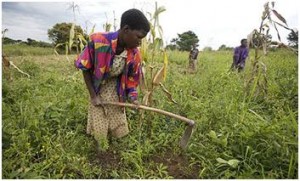 Matu Onyango is a farmer in the region of Nanyuki, 250 km north of Nairobi. His family’s welfare depends solely on the income derived from maize crops. During the last drought that afflicted the region, not only did his crop suffer, but one of his four children fell seriously ill. Thus, Matu’s income fell just as his daughter’s illness caused his expenses to spike; the combination forced him to exhaust his family’s savings, throwing the whole household deeper into poverty.
Matu Onyango is a farmer in the region of Nanyuki, 250 km north of Nairobi. His family’s welfare depends solely on the income derived from maize crops. During the last drought that afflicted the region, not only did his crop suffer, but one of his four children fell seriously ill. Thus, Matu’s income fell just as his daughter’s illness caused his expenses to spike; the combination forced him to exhaust his family’s savings, throwing the whole household deeper into poverty.
In the last decade, microinsurance, or insurance designed to serve low-income clients, has become an effective tool in poverty alleviation by giving poor people access to adequate risk-management tools. It does so by reducing their vulnerability to falling back into poverty in times of economic hardship and by allowing them to take advantage of profitable opportunities they otherwise would not be able to. However, according to the International Labour Organization, only “three percent of the low-income people in the world’s 100 poorest countries benefit from microinsurance”, leaving approximately two billion vulnerable to economic shocks. According to the World Bank, “this situation has become a major concern particularly at a time that arrangements to control the [agricultural] markets directly, through prices and stock management, have been discarded as less effective”.
Why is insurance widely available to those in the developed world, but not the poor—whose demand for insurance, given how close they live to the economic brink, is arguably greater? The answer is simple: transaction costs. The cost of selling and underwriting insurance and of administering a claim does not decrease in proportion to the value of the policy. Using traditional channels and processes, insurance companies simply cannot write policies with values below a certain floor without pricing them unrealistically.
The mobile platform, including mobile money, can be used as a tool that reduces these delivery costs. For example, The Syngenta Foundation’s Agriculture Insurance Initiative called Kilimo Salama, which in Kiswahili means “safe farming”, uses a combination of mobile phones and solar-powered weather stations to provide crop insurance to over 5,000 farmers in western and central Kenya. After insuring their crops, and following a period of inclement weather, a panel of experts uses an index system to assess whether a crop is no longer viable, and remits payments back to the farmers via M-Pesa.
British American Insurance (Britak) has also recently launched a new personal accident insurance product that features enrolment and premium payment via M-Kesho, providing further evidence of the emergence of these second-generation services. Premiums can be paid monthly (KSh 69.17 or $US0.82) or even weekly (Ksh 20 or US$0.25), directly from the user’s M-Kesho account, offering users both affordability and convenience.
Offering such services profitably will not only require insurers to keep costs low; they’ll also need to achieve significant scale. If these innovative services and others like them are taken up fast, it suggests that a clever combination of technology, convenience and lower transaction costs could result in a scalable and sustainable tool for risk-mitigation and poverty alleviation in the developing world. We at MMU are optimistic that this is part of a larger trend of increasing sophistication of mobile financial services and will be writing more about this nascent industry in the coming weeks.

